Welcome to our free classical music site

Do you write about classical music? Are you a blogger? Want to team up with Classical Connect? Send us a message, let's talk!

Do you write about classical music? Are you a blogger? Want to team up with Classical Connect? Send us a message, let's talk!
January 14, 2013. Even though César Cui was a minor composer, we decided to mention him because he was a member of The Five (or the Mighty Handful, as they are also known), a group of Russian composers organized by Mily Balakirev, whose birthday we celebrated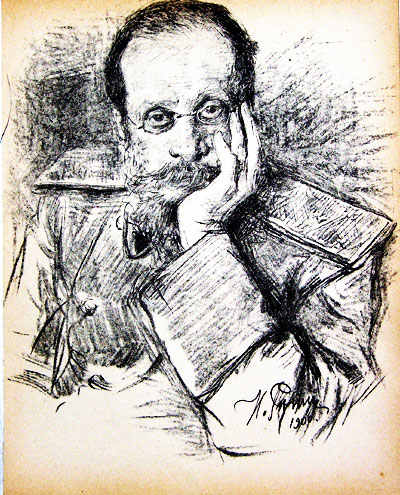 last week. Cui’s father, a Frenchman, entered Russia with Napoleon’s army, and after its catastrophic defeat settled in Vilnius, Lithuania. That’s were César was born, on January 18, 1835. As a boy he received piano lessons, but at the age of 15 was sent to St-Petersburg to prepare for engineering school, which he eventually entered. Upon graduating, he became quite famous for his work on military fortifications; he also taught at several engineering schools. But all along music was his real love, and he expressed it through composing and criticism (Cui wrote more than 800 articles, some of which were quite influential at the time). He composed several operas; these days are rarely staged, although Liszt seemed to have like one of them, William Ratcliff. Cui also wrote a large number of songs, some quite exquisite. Here ’s one, The statue in Tsarskoye Selo, Op.57, no. 17 on a poem by Alexander Pushkin. Recorded in 1954, it is sung by a 25 year-old Nikolai Ghiaurov who at the time was still studying at the Moscow Conservatory; a year later his career was launched. Ghiaurov of course became one of greatest basses of the 20th century. The portrait of Cui on the left is by Ilya Repin.
last week. Cui’s father, a Frenchman, entered Russia with Napoleon’s army, and after its catastrophic defeat settled in Vilnius, Lithuania. That’s were César was born, on January 18, 1835. As a boy he received piano lessons, but at the age of 15 was sent to St-Petersburg to prepare for engineering school, which he eventually entered. Upon graduating, he became quite famous for his work on military fortifications; he also taught at several engineering schools. But all along music was his real love, and he expressed it through composing and criticism (Cui wrote more than 800 articles, some of which were quite influential at the time). He composed several operas; these days are rarely staged, although Liszt seemed to have like one of them, William Ratcliff. Cui also wrote a large number of songs, some quite exquisite. Here ’s one, The statue in Tsarskoye Selo, Op.57, no. 17 on a poem by Alexander Pushkin. Recorded in 1954, it is sung by a 25 year-old Nikolai Ghiaurov who at the time was still studying at the Moscow Conservatory; a year later his career was launched. Ghiaurov of course became one of greatest basses of the 20th century. The portrait of Cui on the left is by Ilya Repin.
Cui’s French connection leads to two composers who were also born this week: Chabrier and Chausson. Emmanuel Chabrier was born in a small town in Auvergne on January 18, 1841. His family moved to Paris when Emmanuel was 15. Even though he was taking music lessons since he was six, his family felt that he should pursue a career in law, for which he was preparing while still in Auvergne. In Paris he entered law school, and upon graduating in 1861 Chabrier became a civil servant with the Interior Ministry. But, not unlike Cui, his real passion was music. He made friends with several young composers, Fauré, Chausson, and d'Indy among them, but also with the leading Impressionst painters, such as Manet, Monet, and Degas: Chabrier started collecting their art early and left behind a large collection of contemporary French art). He also became friends with a number of writers Zola, Daudet, and Mallarmé among them. In 1882 Chabrier visited Spain and a year later wrote his most popular orchestral work, España. You can listen to it here, with Igor Markevitch conducting the Orchestra of Spanish Radio & Television (courtesy of YouTube).
Chabrier’s friend Ernest Chausson was 14 years his younger: Chausson was born on January 20, 1855. His father Prosper was a wealthy contractor who helped Baron Haussmann to rebuild Paris. To please his father, the young Chausson, like Chabrier, studied law, but had very little interest in it. Ernest tried to write and paint, and then at the age of 25 started taking classes in composition with Jules Massenet at the Paris Conservatory. One of Chausson’s best-known works is Poéme, Op. 25. You can listen to it here, performed by Judy Kang , violin, and Kay Kim, piano.
Last week we mentioned the birthday of yet another Frenchman (and one of our favorites), Francis Poulenc. Here is his Piano Concerto in C sharp minor. The pianist is Jean-Bernard Pommier, with The City of London Sinfonia, Richard Hickox conducting.
PermalinkJanuary 7, 2013. In this first post of 2013 we’d like to mention several composers whose birthdays fall on the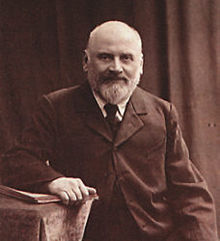 first week of the year: Mily Balakirev, Giovanni Pergolesi, Nikolai Medtner, Max Bruch, and Alexander Scriabin. On top of this, Francis Poulenc was born on this day. A mighty handful for sure. “Mighty handful” was, of course, the name given to a group of Russian composers of the mid-19th century, and Balakirev, born on January 2, 1837, was one of them. Probably not the most talented (musically, Mussorgsky, Borodin, and Rimsky-Korsakov were in a different league), he is now known mostly as an educator and incessant promoter of classical music in Russia. He did, however, compose a piano piece which to this day is considered one of the most difficult, a poem Islamey. Here it is, performed by the Italian pianist Sandro Russo.
first week of the year: Mily Balakirev, Giovanni Pergolesi, Nikolai Medtner, Max Bruch, and Alexander Scriabin. On top of this, Francis Poulenc was born on this day. A mighty handful for sure. “Mighty handful” was, of course, the name given to a group of Russian composers of the mid-19th century, and Balakirev, born on January 2, 1837, was one of them. Probably not the most talented (musically, Mussorgsky, Borodin, and Rimsky-Korsakov were in a different league), he is now known mostly as an educator and incessant promoter of classical music in Russia. He did, however, compose a piano piece which to this day is considered one of the most difficult, a poem Islamey. Here it is, performed by the Italian pianist Sandro Russo.
Giovanni Battista Pergolesi’s life was tragically short. He was born on January 4, 1710 and died at the age of 26, from tuberculosis. He wrote his first opera when he was 21, the first truly successful piece, an intermezzo La Serva Padrona (The Servant Mistress), at the age of 23. He wrote six operas altogether, a violin concerto, and some other secular music, but for the last two years of his life he wrote mostly sacred music. He composed two Masses, several psalm settings and more. You can listen to one of his most famous works, Stabat Mater, here; it’s performed by the Chicago authentic instruments ensemble Baroque Band.
Nikolai Medtner, born on January 5, 1880, was a younger contemporary of the much more famous Rachmaninov and Scriabin, but he wrote a number of charming piano pieces called Tales and several sonatas, some of them very interesting. Here, for example, Marc-André Hamelin plays Medtner’s Piano Sonata no.13, Minacciosa (courtesy of YouTube). As so many artists and composers, Medtner left Russia after the Revolution (he was helped by his friend Rachmaninov) and eventually settled in England. He died in London in 1951. His music is very much worth discovering.
Alexander Scriabin’s music doesn’t need to be "discovered" – it’s being widely played and recorded. Still, his popularity these days cannot be compared to the adulation he receiving during his lifetime (accompanied by some criticism as well). Scriabin was born on January 6, 1872. His early piano compositions were heavily influenced by Chopin, though even then his style was individual and idiosyncratic. Later it evolved, losing most of the romantic traces of the earlier period, and becoming more chromatic and dissonant. Scriabin’s piano works are more popular these days than his orchestra music, but in the pre-Revolutionary Russia his The Poem of Ecstasy was one of the most celebrated composition (he received one of his many Glinka Prizes for it in 1908). Here it is performed by the Chicago Symphony Orchestra, Pierre Boulez conducting (courtesy of YouTube).
We have to mention Max Bruch, born on January 6, 1838 and these days mostly famous for his Violin Concerto. He also wrote a popular Kol Nidrei for cello and orchestra, named after the ancient declaration recited in synagogues before the beginning of the Yom Kippur (Day of Atonement) service. Bruch was a protestant, and introduced to the Jewish prayer by his teacher. Still, many Germans though that Bruch was Jewish, and the Nazis even banned his music. Here’s an arrangement of Kol Nidrei for viola and piano. It’s performed by Viacheslav Dinerchtein, viola, and George Lepauw, piano.
PermalinkDecember 31, 2012. Forgotten birthdays. Throughout the year we’ve celebrated dozens of composers, the great ones, whose work form the foundation of western musical tradition, as well as some minor ones along the way. We try to do it on the weeks of their birthdays, but that creates a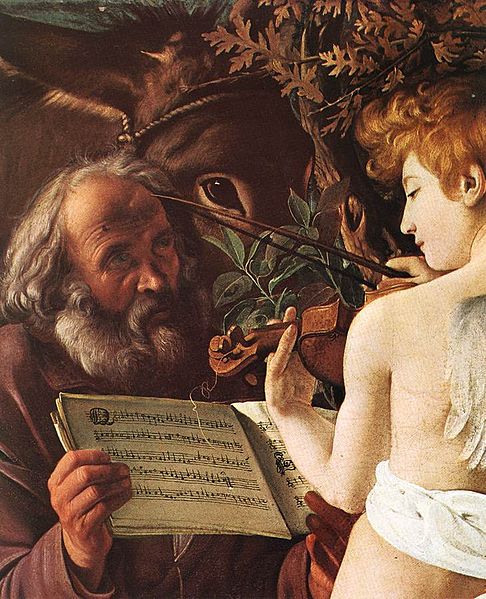 problem: we don’t know when some of the composers were born! Here’s an incomplete list of very influential composers who never made it on our pages for that very reason: Josquin des Prez, who was born sometime around 1450, the supreme master of the Renaissance polyphonic form; Thomas Tallis, one of the greatest early English composers, born around 1505; Orlando di Lasso, sometime spelled as Orlande de Lassus, born around 1530, a Franco-Flemish/Netherlandish composer as Des Prez and also a great master of polyphony; Giovanni Gabrieli, the Venetian born around 1550 and the master of San Marco; Tomás Luis de Victoria, the most famous (and important) Spanish composer of his time, who was also born around 1550; Dietrich Buxtehude, born around 1637, one of the most interesting German Baroque composers of the era preceding Johann Sebastian Bach’s; and there are many more.
problem: we don’t know when some of the composers were born! Here’s an incomplete list of very influential composers who never made it on our pages for that very reason: Josquin des Prez, who was born sometime around 1450, the supreme master of the Renaissance polyphonic form; Thomas Tallis, one of the greatest early English composers, born around 1505; Orlando di Lasso, sometime spelled as Orlande de Lassus, born around 1530, a Franco-Flemish/Netherlandish composer as Des Prez and also a great master of polyphony; Giovanni Gabrieli, the Venetian born around 1550 and the master of San Marco; Tomás Luis de Victoria, the most famous (and important) Spanish composer of his time, who was also born around 1550; Dietrich Buxtehude, born around 1637, one of the most interesting German Baroque composers of the era preceding Johann Sebastian Bach’s; and there are many more.
We’ll write about these composers in the future, but in the mean time here’s from one of our personal favorites, Tomás Luis de Victoria. It’s a short piece for four voices called O vos omnes (Oh, all ye) and it comes from his liturgical setting, Tenebrae Responsories, which is celebrated on early mornings of the last three days of Holy Week. It’s performed by The Tallis Scholars (here, courtesy of YouTube).
The angel playing the violin, above, is by Caravaggio, from his Rest on the Flight into Egypt. He painted it around 1597 in Rome, about 10 years after Victoria left the city, where he lived and studied the previous 20 years, to return to his native Spain.
Happy New Year to all!Permalink
December 24, 2012. Merry Christmas to all!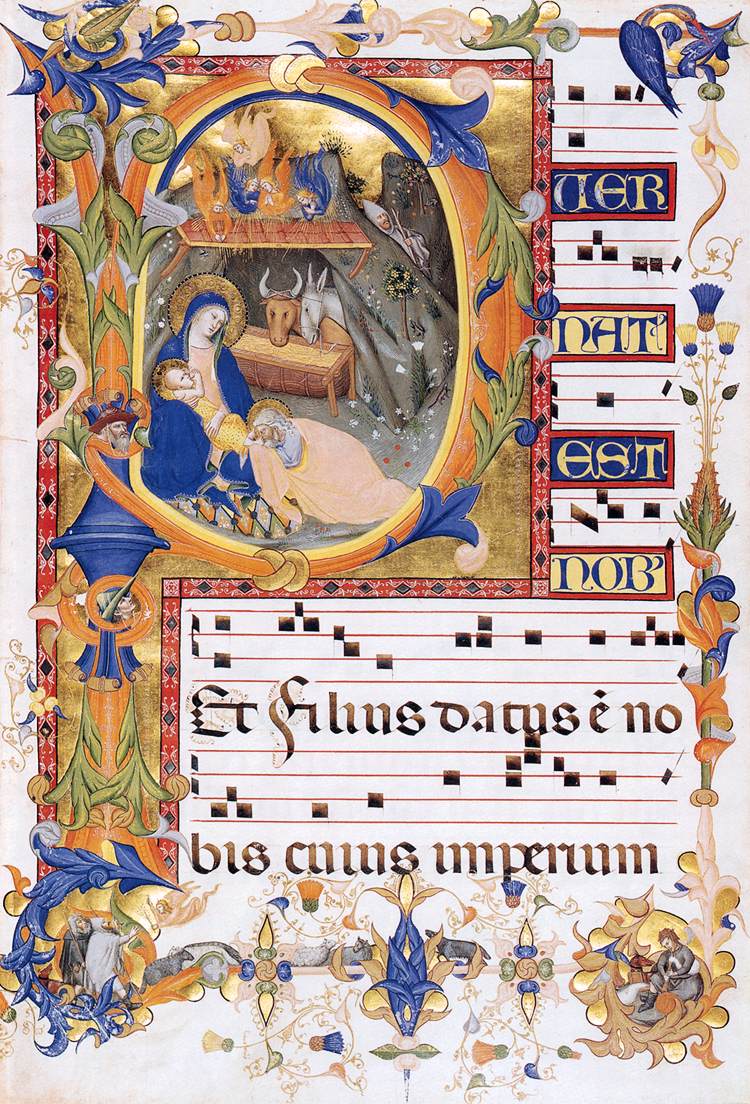 The wonderful leaf from a Choir book you see here comes from 1395 and contains a little bit of music and a little bit of art. The music is the introit (entrance) to the Mass for Christmas Day. The picture represents the Nativity and the Annunciation to the Shepherds. This illustration was created by a monk, Don Silvestro dei Gherarducci who went on to become a rather well known painter (but not as famous as his younger partner, Lorenzo Monaco, who worked with Gherarducci at the same monastery of Santa Maria degli Angeli in Florence).
The wonderful leaf from a Choir book you see here comes from 1395 and contains a little bit of music and a little bit of art. The music is the introit (entrance) to the Mass for Christmas Day. The picture represents the Nativity and the Annunciation to the Shepherds. This illustration was created by a monk, Don Silvestro dei Gherarducci who went on to become a rather well known painter (but not as famous as his younger partner, Lorenzo Monaco, who worked with Gherarducci at the same monastery of Santa Maria degli Angeli in Florence).
And here is the first movement of the first part, Chorus, of Johann Sebastian Bach’s Christmas Oratorio. It starts with Jauchzet, frohlocket, auf, preiset die Tage, or Celebrate, rejoice, rise up and praise these days, a good command to follow. The performance is by the Monteverdi Choir and the English Baroque Soloists under the baton of Sir John Eliot Gardiner (courtesy of YouTube).
PermalinkDecember 17, 2012. Zoltan Kodály. One of the most prominent Hungarian composers of the 20th century, fame he shares with Béla Bartók, Zoltan Kodály was born on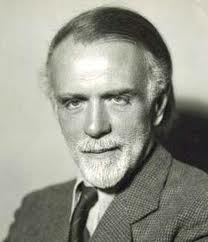 December 16th of 1882 in a small town in central Hungary. As a child he studied the violin with his father, and at the age of 18 entered Budapest University to study languages and, simultaneously, the Hungarian Academy of Music, a composition class of Hans von Koessler. In 1907 he traveled to Paris to study with Charles Vidor at the Paris Conservatory. Starting 1905 he went on regular field trips collecting folksongs, often in the company of Béla Bartók, his lifetime friend. The folk tunes formed the basis of many, highly sophisticated, compositions of Kodály. From 1912 he taught at the Budapest Academy of Music (Antal Dorati was one of his pupils). Here are his Dances of Galánta, composed in 1933. Galánta is a small market town on the old railway line between Vienna and Budapest, where Zoltan spent seven years of his childhood. At that time, a famous gipsy band lived there. According to Kodály, the principle melodies of the Dance come from that music. Throughout his adult life, Kodály was very interested in the problems of music education. The Hungarian music education program that he developed in the 1940s became the basis for what is called the "Kodály Method". Kodály, who was born in the Dual Monarchy and had his most productive period during the Hungarian Republic, lived long enough to see the advent of the Hungarian Peoples Republic – but not the end of it: he died in 1967, at age 84.Permalink
December 16th of 1882 in a small town in central Hungary. As a child he studied the violin with his father, and at the age of 18 entered Budapest University to study languages and, simultaneously, the Hungarian Academy of Music, a composition class of Hans von Koessler. In 1907 he traveled to Paris to study with Charles Vidor at the Paris Conservatory. Starting 1905 he went on regular field trips collecting folksongs, often in the company of Béla Bartók, his lifetime friend. The folk tunes formed the basis of many, highly sophisticated, compositions of Kodály. From 1912 he taught at the Budapest Academy of Music (Antal Dorati was one of his pupils). Here are his Dances of Galánta, composed in 1933. Galánta is a small market town on the old railway line between Vienna and Budapest, where Zoltan spent seven years of his childhood. At that time, a famous gipsy band lived there. According to Kodály, the principle melodies of the Dance come from that music. Throughout his adult life, Kodály was very interested in the problems of music education. The Hungarian music education program that he developed in the 1940s became the basis for what is called the "Kodály Method". Kodály, who was born in the Dual Monarchy and had his most productive period during the Hungarian Republic, lived long enough to see the advent of the Hungarian Peoples Republic – but not the end of it: he died in 1967, at age 84.Permalink
December 16, 2012. Beethoven! Today is the day to celebrate the 242nd anniversary of Ludwig van Beethoven’s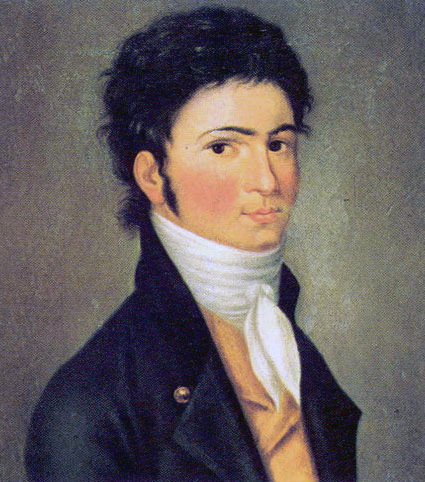 birthday. Here’s Sviatoslav Richter’s performance of Beethoven’s Piano Sonata no. 1 in f minor, op. 2, no.1. The very first one of the eventual 32, the set that is still the pinnacle of piano literature, this sonata was written in 1795. The young Beethoven dedicated it to his teacher of several years, Franz Joseph Haydn. The portrait, by Carl Traugott Riedel, was made a bit later, in 1801.
birthday. Here’s Sviatoslav Richter’s performance of Beethoven’s Piano Sonata no. 1 in f minor, op. 2, no.1. The very first one of the eventual 32, the set that is still the pinnacle of piano literature, this sonata was written in 1795. The young Beethoven dedicated it to his teacher of several years, Franz Joseph Haydn. The portrait, by Carl Traugott Riedel, was made a bit later, in 1801.
Permalink